Please RSVP by 7th May 2025

Egle & Jamie
Please RSVP by 7th May 2025
Egle & Jamie
Things to Do
THINGS TO DO
Curonian Spit
The main highlights in Nida include Parnidis Dune and its solar clock (see below), the Thomas Mann House-Museum, the Nida Fisherman’s Ethnographic Homestead, and the Amber Gallery. Don’t miss the historic part of town, with its colourful fishermen’s houses, as well as the waterfront promenade along the Curonian Lagoon!
1. Parnidis Dune & Sundial
At 52 meters, Parnidis Dune is one of Europe’s highest shifting dunes. The views from the top are simply breathtaking! The landscape is stunning, with endless white sand dunes on one side and lush pine forests on the other. From the summit, you can see both the Curonian Lagoon and the Baltic Sea.
On top of Parnidis Dune, you’ll also find a few sculptures and a large sundial. If it's a sunny day, try to figure out how the sundial works!
TIP: If you’re staying in Nida, try to visit early in the morning or at sunset (my personal favorite time). As one of the most popular spots on the Curonian Spit, it tends to get quite busy during the day, especially in summer.
How to visit: You can reach Parnidis Dune by car, but the best way is to take the Parnidis Cognitive Path from Nida.

2. Nagliai Nature Reserve
The Curonian Spit’s biggest attraction is its dunes, and another great place to see them is the Nagliai Nature Reserve. Located right off the main road between Juodkrantė and Pervalka, this spot is a must-see on any Curonian Spit itinerary.
Locals call these dunes the Grey Dunes (Pilkosios Kopos) or the Dead Dunes (Mirusios Kopos). However, on the map, you'll find the area listed as the Cognitive Trail in Nagliai Nature Reserve.
The reserve is vast, but most of it is protected, so visitors can no longer wander freely. The best way to explore is by following a wooden boardwalk, which leads to a short climb up one of the dunes.
How to visit: You can reach Nagliai Nature Reserve by car or as part of a guided tour. The spot is popular with groups, and the small parking area next to the road fills up quickly, so it's best to visit early in the morning or late in the afternoon. In the high season, there’s a small fee to enter the reserve.
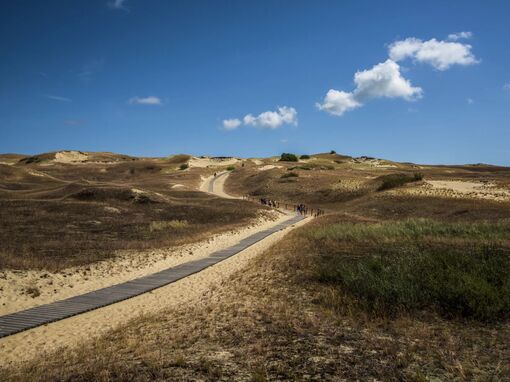
3. Juodkrantė
Juodkrantė is the second-largest town on the Curonian Spit. Popular with Lithuanians who come here for their summer vacations, it tends to be just a quick stop for most foreign visitors.
The main attraction in Juodkrantė is the Hill of Witches (Lithuanian: Raganų Kalnas), which is the town’s most visited site. It’s essentially an open-air folk art sculpture park. Opened in 1979, it originally began as a creative camp for local craftsmen and has since grown to feature over 80 pieces of art.
As you stroll through the forest, you’ll encounter a variety of wooden sculptures depicting Lithuanian fairytale characters. Most of the sculptures are of witches and devils, though you’ll also spot demons and dragons.
The devilish theme is no accident—there are numerous folk stories and legends tied to this hill. According to some of these tales, witches and devils used to host wild parties here long before humans did.
How to visit: The Hill of Witches is always open and free to visit. Expect to spend 20 to 40 minutes exploring. There’s a small parking area nearby, along with souvenir shops and bathroom facilities.
If you have some extra time, take a walk along the scenic promenade by the Curonian Lagoon. You can also visit the outdoor Stone Sculpture Park or the small Amber Bay to the north of town. In summer, there’s often an outdoor exhibition of sand sculptures as well.
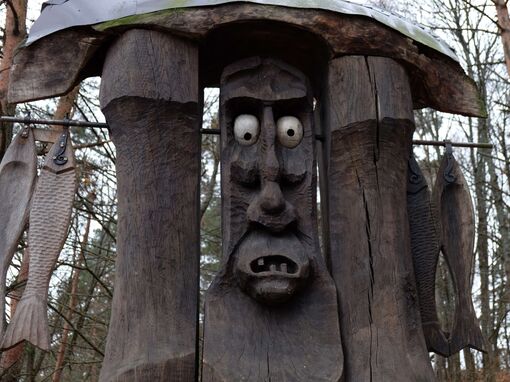
4. Lithuanian Sea Museum
The Lithuanian Sea Museum is the only attraction on this list located outside the Curonian Spit National Park, situated in Smiltynė.
The museum offers a great selection of marine life, including large aquariums, an aquarium tunnel, and even dolphin and seal shows.
Housed in a historic fort, the museum also displays several old fishing vessels. Additionally, you can visit the Fisherman’s House-Museum, which provides insight into life in this area at the turn of the 20th century.
The Fisherman’s House-Museum is free to visit, so even if you're not particularly interested in marine animals like fish, penguins, or dolphins, it’s still worth checking out the historic homestead.
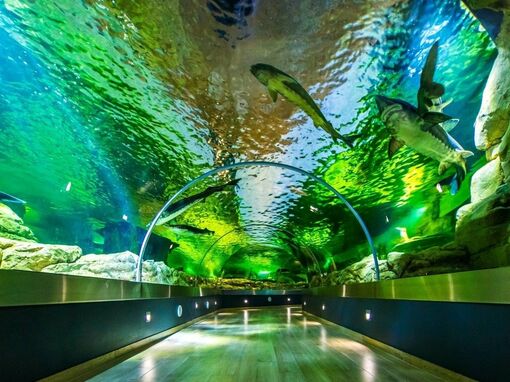
5. Beaches & Water Sports
The Curonian Spit is famous for its long, unspoiled beaches of white sand and towering pine trees. On sunny, warm days, the beaches near larger towns can get quite crowded, but it's still nothing compared to the busy shores of Spain or France. If you're willing to walk a little further, you’ll likely find a quiet stretch of beach all to yourself. Visit on a cold, windy summer day or during the off-season, and you'll probably have the whole beach to yourself—it's truly magical!
If you're visiting in the summer, you’ll find plenty of opportunities for water sports and boat rentals. Various boat trips are available, with most departing from Nida. The most popular day trip is to Ventė Cape (Lithuanian: Ventės Ragas), located on the opposite side of the Curonian Lagoon at the delta of the Nemunas River, Lithuania's largest river. It's a prime spot for birdwatching, especially during migration season.
Longer tours also include a stop at Mingės village, also known as the "Venice of Lithuania," and typically feature a one-hour bus ride to Ventė Cape, followed by a traditional fish soup lunch or dinner.
For a shorter excursion, you can take boat trips from Nida along the coast to view the sand dunes from the water. Fishing trips are also available.
6. Local Food, Amber & More
After exploring the stunning sights of the Curonian Spit, be sure to savour some local Lithuanian food, visit a gallery or museum, or pick up a traditional Lithuanian souvenir.
One of the region's specialties is smoked fish—no trip to the Curonian Spit is complete without trying it. You’ll find plenty of places selling smoked fish in both Nida and Juodkrantė. Look for signs that say Rūkyta žuvis or Rūkytos žuvys.
Amber is another local treasure, especially in this part of Lithuania. Most souvenir shops offer a wide range of amber products, from simple jewelry to intricate works of art. If you’d like to learn more about amber, consider visiting the Amber Gallery-Museum in Nida.
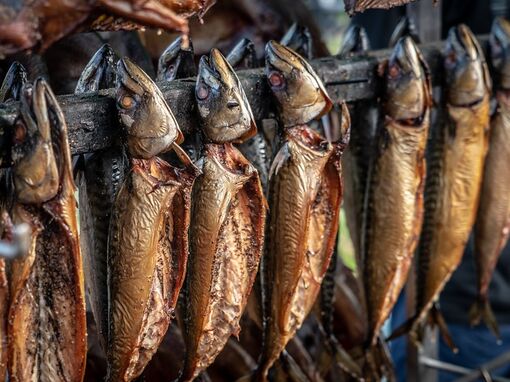
Klaipėda
1. Explore the Old Town
During WWII, Klaipėda lost a significant portion of its heritage. Before then, the old town was one of the most beautiful areas in Northern Europe.
The Old Town is the city’s most historic district, featuring unique fachwerk (half-timbered) architecture. One of the best places to admire these buildings is the Art Yard (Daržų g. 10 / Bažnyčių g. 4), an arts and crafts space in Klaipėda.
Begin your visit at the heart of the city, in the beautifully restored Theatre Square. The magnificent Drama Theatre is the focal point, and if you look up to the balcony, you’ll see a piece of history: it was from this very spot that Hitler announced Klaipėda’s annexation to Germany. It wasn’t a voluntary union—Hitler had threatened to occupy the entire country if the Lithuanian government refused the ultimatum.
In the square, you’ll also find the Ann from Tharau statue, dedicated to Simon Dach, a German poet born in Klaipėda. Legend has it that Hitler ordered the statue's removal from its original location, deeming it obstructive.
Another charming spot to visit is Friedricho Pasažas (Friedrich Arcade), a beautifully restored area that was once filled with dull Soviet-era offices. Now, the historic buildings have been revived, and the arcade serves as a peaceful retreat for locals and tourists alike. In the summer, you’ll often find live local music performances in the courtyard. It’s a great place to relax, grab a coffee, or enjoy a meal.
2. Walk Along the Dane River
Enjoy a relaxing stroll along the Dane River. You can walk south towards the Old Ferry Port or head north towards the Botanical Gardens. A great starting point is the historic Biržos Bridge.
No matter which direction you choose, make sure to stop by and admire the Meridianas ship, which is moored along the riverbank.
The Botanical Garden, part of Klaipėda University, is open to visitors from 9 a.m. to 5 p.m. on weekdays and from 10 a.m. to 5 p.m. on weekends. If you have a green thumb, you’ll love exploring the garden, which features around 250 species of plants that naturally grow in the area.
While you’re walking, don’t forget to check out the Little Mermaid statue beneath the bridge, on the right bank of the river. It’s a recent addition to the collection of mermaid statues scattered across Europe.
This particular mermaid is unique—take a close look at her tail. It’s crafted from pre-Euro Lithuanian coins, making it a special tribute to the country’s former currency, which no longer exists.
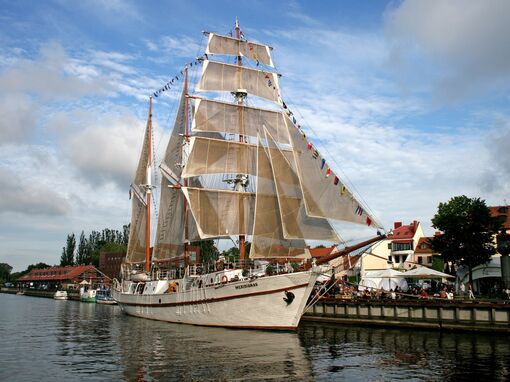
Top Tip: Download this article as a self-guided walking tour on your smartphone. Check out our Klaipeda City walk on gpsmycity.com
3. Explore the Seaside of Klaipėda
Dutchman's Cap (Olando Kepurė) – Situated in the Seaside Regional Park, Dutchman's Cap is a striking natural feature worth exploring. This sand cliff began to form 12,000 to 15,000 years ago during the last Baltic glaciation.
Standing at an impressive 24.4 meters, the cliff offers stunning views of the Baltic coast and the surrounding pebble beaches.
The cliff is in a constant struggle with the sea, as powerful waves threaten to erode the fragile sand bluff. Due to its delicate landscape, this area is protected and listed as a national heritage site in Lithuania.
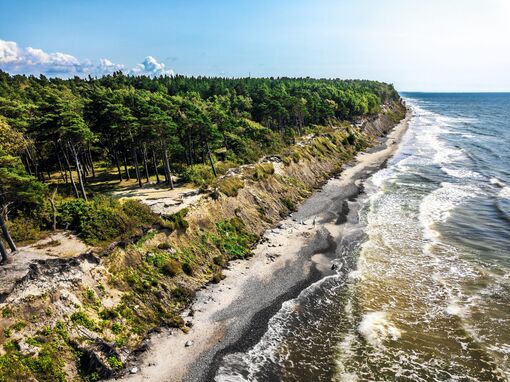
Klaipėda Pier
The Klaipėda Pier, which marks the entrance to the Klaipėda Port, consists of both the southern and northern piers. These piers serve a crucial role in protecting the port from waves, ice, and drift. But beyond its functional purpose, the pier has become a beloved spot for both locals and visitors.
The North Pier is particularly popular for leisurely seaside walks, watching sunsets, and observing ships as they arrive and depart. It’s a favorite hangout for the people of Klaipėda, as well as tourists. The area also hosts training sessions and day camps for water sports such as surfing, paddleboarding, kitesurfing, and sea kayaking, making it a great destination for those who enjoy active leisure. Whether you’re looking for a peaceful stroll or an adrenaline rush, the pier offers something for everyone.
This is also the place to experience the raw power of the sea waves and soak up the authentic atmosphere of a working port city.
Address: Vėtros St. 9, Klaipėda (Northern Melnragė Pier)
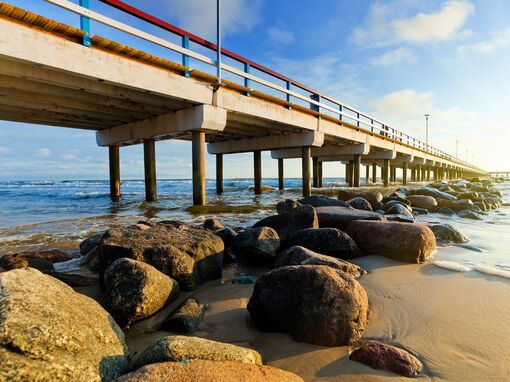
4. Restaurants and Food Experiences
Monai – This is the top spot for great food in Klaipėda, and last year, it was included in the Michelin Guide
Alba Bistro – A modern Italian restaurant located in the heart of the city, perfect for those craving a taste of Italy
Baltas Ruonis – Located on Melnragė Beach in Klaipėda, this restaurant offers a spacious terrace with beautiful sea views
Toli nuo Klasikos – Situated in Melnragė, near the beach, this unique place not only serves food but also offers a memorable experience
Klaipėdos Senamiestis – A must-visit for food lovers—try the legendary cheese fingers here
Švyturys Bhouse – Ideal for beer lovers, this brewery offers beer tastings and a great selection of food
Pepper Grey – A bit outside the city, but well-known among food enthusiasts. This is a go-to spot for those who appreciate good food
Viva La Vita – A panoramic sky bar offering stunning views of the city, perfect for sipping cocktails
Traditional Food Restaurants
Friedrich Passage (Friedricho Smuklė)
Etno Dvaras
Traditional Lithuanian Dishes to Try
Šaltibarščiai – Lithuanian cold beetroot soup
Sour Cabbage Soup
Cepelinai – Potato dumplings stuffed with meat
Kepta Duona – Fried bread sticks with melted cheese
Rye Bread – A staple of Lithuanian cuisine
Potato Pancakes
Kūgelis – A hearty potato pudding
Žemaitiškas Kąstinys – A traditional dish with potatoes
Šakotis – A unique tree-shaped cake
Šimtalapis – A cake with one hundred layers, filled with poppy seeds

Palanga
1. Palanga Amber Museum & Pier of Palanga
Palanga is the most popular seaside town in Lithuania, attracting thousands of Lithuanians who spend their summer holidays at its beautiful beach.
The town offers a unique blend of nature, forests, and stunning white-sand beaches, alongside the lively and bustling Basanavičiaus Street, which often feels like a country fair with its vibrant crowds and noise. However, if you can overlook the hustle and bustle, you’ll find that Palanga is actually a charming town worth exploring.
Palangos Gintaro Muziejus (Palanga Amber Museum) is housed in the beautifully restored 19th-century Tiškevičiai Palace, nestled within the serene Palanga Botanical Garden (Birutės Park). The museum showcases an impressive collection of Lithuanian amber, often referred to as "Lithuanian gold."
Another must-see in Palanga is Palangos Tiltas (Palanga Pier). This iconic wooden pier stretches far into the sea and is one of the best spots to watch the sunset, offering breathtaking views over the Baltic.
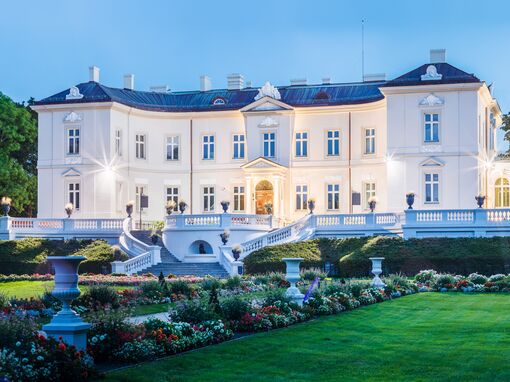
2. The Most Holy Virgin Mary’s Ascension Church
The Most Holy Virgin Mary’s Ascension Church in Palanga is definitely worth a visit. Built over a century ago, it captivates the attention of passersby with its stunning neo-Gothic architecture and grandeur.
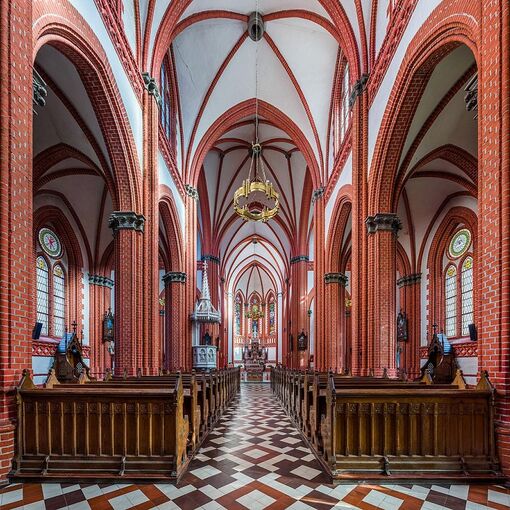
3. Entertainment & food
Atostogu parkas "Holiday Park" is the largest recreation and wellness complex in Western Lithuania, offering 16 swimming pools designed for relaxation and wellness. After unwinding at Holiday Park, head to HBH Palanga for a hearty lunch or dinner. This traditional Lithuanian restaurant and family-friendly entertainment park is a perfect spot to enjoy local cuisine.
Places for Great Food:
Vila Komoda – A European cuisine restaurant that was added to the Michelin Guide last year.
Toda – A Middle Eastern restaurant offering a flavorful and exotic dining experience.
Pušų Paunksmėje – An European and seafood restaurant owned by the famous Lithuanian basketball player Arvydas Sabonis.
Onore Restaurant – Serving international and European cuisine in a stylish setting.
Selfish Palanga – A seafood lover’s paradise with fresh, locally sourced ingredients.
Old Man – A cozy spot known for its live band performances in the evenings, perfect for a relaxed atmosphere.